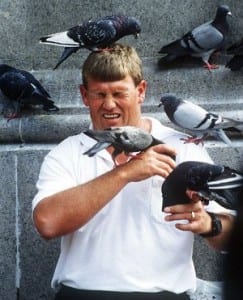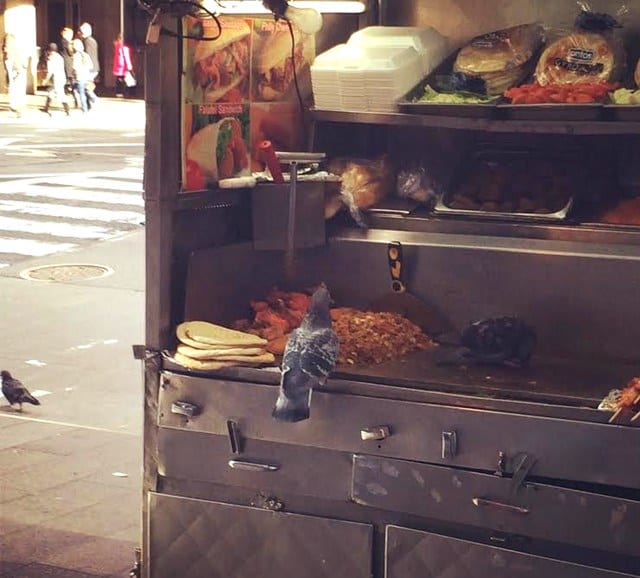
by Pigeon Patrol | Mar 31, 2015 | Animal Deterrent Products, Pigeons in the News
 A 26-year-old transient was arrested Wednesday on a charge of cruelty to animals after a wing was ripped off a live pigeon in a parking lot at 221 W. Union St., according to the Jacksonville Sheriff’s Office.
A 26-year-old transient was arrested Wednesday on a charge of cruelty to animals after a wing was ripped off a live pigeon in a parking lot at 221 W. Union St., according to the Jacksonville Sheriff’s Office.
Simon Abromson remains in the Duval County jail on $10,000 bail after his 1 p.m. arrest, according to jail records.
Abromson was feeding birds in the parking lot at noon Monday and threw bread on the ground to gather birds, a witness told police. After gathering birds around him, he grabbed one pigeon and ripped off a wing before it fell back to the ground. The bird tried to run away, but died behind a dumpster, according to the arrest report.
The witness confronted Abromson about torturing the bird and was told to “back off or I’ll slit your throat and drink your blood,” according to the arrest report.
Police found the man two days later, but he became violent when arrested and said he would come back and shoot people in the parking lot. The man told police he eats pigeons regularly, according to the arrest report.
Pigeon Patrol Products & Services is the leading manufacturer and distributor of bird deterrent (control) products in Canada. Pigeon Patrol products have solved pest bird problems in industrial, commercial, and residential settings since 2000, by using safe and humane bird deterrents with only bird and animal friendly solutions. At Pigeon Patrol, we manufacture and offer a variety of bird deterrents, ranging from Ultra-flex Bird Spikes with UV protection, Bird Netting, 4-S Gel and the best Ultrasonic and audible sound devices on the market today.
Voted Best Canadian wholesaler for Bird Deterrent products four years in a row.

by Pigeon Patrol | Mar 19, 2015 | 4-S Gel Bird repellent, Bird Deterrent Products, Bird Netting, Pigeon Spikes, Pigeons in the News
 When it comes to reducing collisions with the glass of the new Minnesota Vikings stadium, a bird in the hand is worth two in the bush, environmental advocates told stadium officials Friday.
When it comes to reducing collisions with the glass of the new Minnesota Vikings stadium, a bird in the hand is worth two in the bush, environmental advocates told stadium officials Friday.
There’s already a proven solution — “fritted” or patterned glass — which would cost only about $1 million and is being used successfully at places such as the Javits Center in New York City, they say. That’s better than waiting for a potential fix from 3M that might never come to fruition.
Michele Kelm-Helgen, chair of the Minnesota Sports Facilities Authority, which is overseeing construction of the new $1 billion facility, said at a Friday morning meeting that she was open to a fuller discussion of the issue next month but that “the glass decision on the building has been made.”
The transparent design was approved after vetting by several stakeholder groups and is part of what will make the stadium “an iconic building that people are going to want to be part of,” Kelm-Helgen said. Fritted glass would clash with that look, officials have said.
If there is a solution from 3M that would be transparent to humans but detectable by birds and is possibly more energy efficient to boot, “that would be a very win-win situation for all of us, and so that’s why we’re working on that and pursuing that,” Kelm-Helgen said.
She confirmed earlier this month that the authority was in talks with 3M, the Vikings and the Audubon Society about testing possible “bird-safe window film solutions.”
The status of any such product was unclear Friday.
Kelm-Helgen said that 3M has said it has some existing products it wants to test for bird-deterrent qualities, as well as some new products under development that might work. She stressed that it’s early in the process and details aren’t finalized.
“There is no product yet,” said 3M spokeswoman Fanna Haile-Selassie. Company scientists believe they may be able to find a solution, hopefully by this spring, Haile-Selassie said.
All of which makes some bird advocates suspect the 3M possibility is a red herring being floated by the authority to distract from the fritted glass solution.
“It’s absurd, absolutely absurd, that you’re now pointing to a possible future solution and taking refuge in that as some kind of action that you’re taking to deal with this massacre of birds that’s going to occur unless you change course and change the glass,” Constance Pepin of Minneapolis told authority members.
Brad Bourn, a member of the Minneapolis Park and Recreation Board, said a $1 million fix on a billion-dollar project would be “the equivalent on the park board of painting a swing-set blue instead of green in the final design.”
But Kelm-Helgen said the $1 million is only the cost for the fritted glass. Changing direction at this point also would mean wasting the glass already fabricated for the project, the value of which she said she couldn’t estimate. Plus it would necessitate a redesign and cause a delay, the duration of which she said she was not sure of.
And authority board member John Griffith assured bird advocates they were being heard. “I think that they’ve shown that there’s a large constituency that cares very much about this issue,” he said.
Griffith said he’s personally affected when he sees birds that have died after colliding with buildings. “Every once in a while, whether it’s downtown Minneapolis or wherever, you see one of those little fellows on the sidewalk. It bums me out, there’s no question about that.”
Testing of a bird-safe solution this spring would begin on other existing buildings, Kelm-Helgen said, with the stadium being added to the test after the building is finished in 2016.
The new stadium will have about 190,000 square feet of glass. It sits in downtown Minneapolis in what’s called the “Mississippi flyway” for migrating birds.
About Pigeon Patrol:
Pigeon Patrol Products & Services is the leading manufacturer and distributor of bird deterrent (control) products in Canada. Pigeon Patrol products have solved pest bird problems in industrial, commercial, and residential settings since 2000, by using safe and humane bird deterrents with only bird and animal friendly solutions. At Pigeon Patrol, we manufacture and offer a variety of bird deterrents, ranging from Ultra-flex Bird Spikes with UV protection, Bird Netting, 4-S Gel and the best Ultrasonic and audible sound devices on the market today.
Voted Best Canadian wholesaler for Bird Deterrent products four years in a row.
Contact Info: 1- 877– 4– NO-BIRD (www.pigeonpatrol.ca)

by Pigeon Patrol | Feb 26, 2015 | Animal Deterrent Products, Bird Deterrent Products, Bird Netting, Pigeon Patrol's Services, Pigeon Spikes, Pigeons in the News, UltraSonic Bird Control
Scarecrows have never worked, and history shows that advancements in technology haven’t worked much better when it comes to shooing birds away from ripening crops.
“You set out propane cannons, they’ll habituate. You broadcast predator calls, they’ll learn to ignore them. They’ll even get used to packs of angry wiener dogs,” said Mark Hinders. “About the only things that work to exclude birds are nets, guns and poison. But those are expensive and/or bad manners.”
Hinders, professor of applied science, and John Swaddle, professor of biology, are the core members of the Sonic Nets collaboration at William & Mary. The idea is to produce an effective, non-lethal bird deterrent, a solution to an age-old problem that is affordable, polite and does not rely on a steady supply of irritable dachshunds.
Instead of scaring or even alarming the birds, Sonic Nets works on the annoyance principle. As they dine in a farmer’s field, birds keep up a constant chatter. A device called a parametric array projects a narrow beam of sound to disrupt the birds’ field chatter, which seems to be mainly about the quality of the hors d’oeuvres and the immediate predator situation.
Like a noisy cocktail party
“It’s like the cocktail party problem,” Hinders explained. “You’re in a room and a lot of people are talking and it can be difficult to follow an individual conversation. It doesn’t even have to be especially loud. It’s just that all those other people’s words fill in the empty spaces. And so you go to a quiet room so that you can hear.”
The Sonic Nets collaboration has attracted considerable interest over the years, beginning in 2012, when the Bill and Melinda Gates Foundation named the project a Grand Challenges Explorations winner. Additional support from the Andrew W. Mellon Foundation allowed birdsong expert Dana Moseley to join the collaboration in fall, 2014 as a Mellon postdoctoral fellow.
There also has been considerable movement toward eventual commercialization of Sonic Nets, as well. The collaborators have been discussing options with a group of M.B.A. students at William & Mary’s Raymond A. Mason School of Business under the leadership of Richard Ash, executive director of the Mason School’s Alan B. Miller Center for Entrepreneurship. A patent application for the parametric array system is under consideration, and Sonic Nets has entered into a partnership with Midstream Technology, a Williamsburg firm, to pursue commercial opportunities.
The technology was first tested with starlings in William & Mary’s aviary. Those encouraging results led to a summer of field tests at Fort Eustis. Swaddle explained that the Fort Eustis tests included an examination of a completely different use for the parametric array—minimizing bird-aircraft collisions by chasing birds away from runways. The airfield work is funded by the Virginia Center for Innovative Technology.
“We surveyed bird activity at three places at the airfield four times a week for eight weeks,” Swaddle said. “The first four weeks gave us a baseline of bird activity. During the second four weeks, we deployed our Sonic Net at one of the sites—and recorded an approximate 85 percent reduction in the presence of birds in that area.”
Testing in an open field
The instrumentation shack (left) holds the white rectangular parametric array aimed at the elevated food tray.
They also field-tested the devices in an open field, with the action recorded on video. The video footage from the open-field tests is still being processed, but Swaddle said the airfield data exceeded their expectations. The aviary tests showed that the Sonic Nets reduced the presence of starlings at food by 50 percent. He suggested that the higher success rate at the airfield is probably due to the difference between wariness of wild birds versus captive starlings.
“After our aviary testing, we thought that we would see a stronger effect in the field, but not as strong as we recorded,” Swaddle said. “We think the Sonic Net works because birds can’t hear alarm calls or predators. In the aviary, there isn’t much threat. In the wild, there are plenty of threats and so there is greater need for birds to hear these calls.”
Bird vocalization is much more rich and diverse than calls to alert the flock to the presence of predators or food. Moseley’s Ph.D. research centered on how males use songs to attract potential mates as well as ward off rivals. The breeding-related vocalizations are yet another aspect of the deep aural avian experience.
“It’s interesting to think about how the world of birds is such an acoustic world,” Moseley said. “It can be hard for us to see some little brown bird in a bush. And it’s hard for them to see each other too in a bush or in a forest, or even in a field. The way that they are able to interact with their environment is especially through sound.”
‘Soundscape’ theory
The wide-frequency capabilities of the apparatus open up the potential for “tuning” the Sonic Nets sound to target particular species. Nonlinear acoustics principles incorporated into design of the speakers also allow the operator to “focus” the sound right at the birds, and only the birds.She explained that there is some evidence that “soundscape” is a factor in habitat choice—that birds show a preference for a place where their songs and calls will best resonate. Moseley noted that the Sonic Nets apparatus could be used as research tool to test the soundscape-preference hypothesis, using its wide-frequency range to select sound that would alter the acoustic landscape of a test plot to observe if sound changes the bird’s perception of a habitat.
“If you do it just right you can get that narrow beam of sound to cancel itself out after it propagates a certain distance,” Hinders explained. “This control over where the sound goes allows us to cover a particular region with a blanket of sound. Inside that area the birds can’t communicate, so they leave. Outside that area, nothing—so we don’t generate any noise pollution.”
Graduate student Elizabeth Skinner sets up speakers at an airfield.
Elizabeth Skinner, a Ph.D. student in applied science, is working on simulations of how the sound beams interact with air. Her aim is to fine-tune the controls of the sound, setting the stage for Sonic Nets arrays tailored for specific situations.
“There are some applications where we’re going to want to cover a huge area, and there are others, like on the edge of a golf course, where you’re going to want to cut the sound off before you get to the course itself, so that you don’t bother the golfers,” she said. “My simulations allow us to see where the sounds are going to go before we build the speaker.”
Speakers, described as light sources
The team likes to compare different speaker designs to light sources. A regular speaker, Skinner explained, can be compared to a normal incandescent light bulb, illuminating a room, although diminishing with distance.
“Whereas, a parametric array would be like a flashlight. You can point it, direct it,” she said. “And then the limited parametric array that we’re working on is more like a light saber, where it will just cut off at a certain distance, but up to that distance, you’ll still have that defined beam.”
Sonic Nets is versatile in concept, but one size does not fit all applications. Scaling up—spreading out the sound—is easier than confining the sound to a defined space, Hinders said.
The team is working on variations in speaker design, sound and power source to engineer a Sonic Nets solution to any number of site-specific bird-pest problems. There is an almost limitless variety of bird issues, with consequences ranging from life-and-death to the most trivial of First-World Problems, Hinders said. Each problem poses a different set of engineering challenges.“If we need to cover a sunflower field in North Dakota, we would simply repurpose a stripped-down version of an emergency-alert kind of siren or maybe the PA system for a stadium,” he said. Other agricultural applications might be as small as a portion of an acre or a couple rows of fruit trees, Swaddle added.
“There are particular birds in sub-Saharan Africa that come and eat your rice and make your kids starve, so you want to encourage them to go somewhere else. The new football stadium in Minneapolis happens to be right in the major flyway for lots and lots of birds and apparently they are building this with lots of glass and they have to do something to head off a plague of bird deaths. A technology like this might be just what the NFL needs to avoid yet another run of bad press,” he said. “It could be pigeons pooping on the cars in your parking lot. It could be gulls pooping on your yacht. ”
Next: More testing, more speaker design, more research
Next steps for the project include more extensive field testing, speaker design, various technology-transfer options and getting a better understanding of aspects of both the avian and the human condition. The collaborators stress that they want to be careful to work with people who would use Sonic Nets applications, to understand the bird and the problem it’s causing.
Hinders said the group hopes to introduce use of the technology in resource-poor areas such as sub-Saharan Africa. He has begun leveraging existing contacts, starting with consultations with a young Tanzanian who is about to get a degree in wildlife management, thanks to the support from St. Stephen’s Lutheran Church in Williamsburg.
“The world is in fact that small,” Hinders said. “As we develop this technology, partnering with a small company who intends to make money, we also have in mind the social entrepreneurship angle where we’re solving the actual problem in a place like Tanzania. The engineering challenge is to engineer enough cost and complexity out of it that can actually solve the problem.”
About Pigeon Patrol:
Pigeon Patrol Products & Services is the leading manufacturer and distributor of bird deterrent (control) products in Canada. Pigeon Patrol products have solved pest bird problems in industrial, commercial, and residential settings since 2000, by using safe and humane bird deterrents with only bird and animal friendly solutions. At Pigeon Patrol, we manufacture and offer a variety of bird deterrents, ranging from Ultra-flex Bird Spikes with UV protection, Bird Netting, 4-S Gel and the best Ultrasonic and audible sound devices on the market today.
Voted Best Canadian wholesaler for Bird Deterrent products four years in a row.
Contact Info: 1- 877– 4– NO-BIRD (www.pigeonpatrol.ca)

by Pigeon Patrol | Feb 26, 2015 | Bird Deterrent Products, Pigeon Patrol's Services, Pigeons in the News
 Part of what makes New Yorkers different from Everyone Else is that we can do things like ingest cockroaches, rusty nail salad, mouse-dropping Cronuts, and subway air and survive. Taking things that don’t belong anywhere inside of the human body and placing them inside of our human bodies—even if unknowingly—is like our super power. A little hair on your dirty water dog? No time to remove it, you’ve got places to be! Wake up with a cockroach crawling into your mouth? That’s a delicacy for some! Things like this have, over time, built up our immunity. But we have to draw lines somewhere, and that somewhere is probably right about here.
Part of what makes New Yorkers different from Everyone Else is that we can do things like ingest cockroaches, rusty nail salad, mouse-dropping Cronuts, and subway air and survive. Taking things that don’t belong anywhere inside of the human body and placing them inside of our human bodies—even if unknowingly—is like our super power. A little hair on your dirty water dog? No time to remove it, you’ve got places to be! Wake up with a cockroach crawling into your mouth? That’s a delicacy for some! Things like this have, over time, built up our immunity. But we have to draw lines somewhere, and that somewhere is probably right about here.
Sara Rodich snapped this photo at a street cart on 49th Street and 6th Avenue two weeks ago, and tells us, “The owner was nowhere to be found! The pigeons were eating on the cart for a solid 10 minutes.” Hold up: pigeons, plural? That’s right, “There were two pigeons,” Rodich points out, “one was standing on the grill eating the food and the other was just perched on the side.”
We’re just going to have to accept that this probably happens a lot. In fact, 9 out of 10 of us have probably dined on a pigeon-seasoned falafel. But you know what? We survived. The best we can do now is just block this image from our collective mind and keep going.
About Pigeon Patrol:
Pigeon Patrol Products & Services is the leading manufacturer and distributor of bird deterrent (control) products in Canada. Pigeon Patrol products have solved pest bird problems in industrial, commercial, and residential settings since 2000, by using safe and humane bird deterrents with only bird and animal friendly solutions. At Pigeon Patrol, we manufacture and offer a variety of bird deterrents, ranging from Ultra-flex Bird Spikes with UV protection, Bird Netting, 4-S Gel and the best Ultrasonic and audible sound devices on the market today.
Voted Best Canadian wholesaler for Bird Deterrent products four years in a row.
Contact Info: 1- 877– 4– NO-BIRD (www.pigeonpatrol.ca)

by Pigeon Patrol | Feb 11, 2015 | Bird Deterrent Products, Bird Netting, Pigeon Patrol's Services, Pigeon Spikes, Pigeons in the News
 Cannibalistic pigeons at a Farnborough hospital have been branded ‘disgusting’.
Cannibalistic pigeons at a Farnborough hospital have been branded ‘disgusting’.
The dead birds have been spotted at the Princess Royal University Hospital, on Farnborough Common.
A net preventing the winged beasts from flying near the hospital has inadvertently become their death chamber, witnesses claim.
Some of the feathered creatures, which gather round the tops of the buildings, are reportedly left to rot or are devoured while hanging in the net below.
It is unclear whether they become trapped in the net and die, or simply fall after dying of natural causes.
One hospital visitor, Joan Collins of Southend Road in Beckenham, said: “It’s disgusting, it’s absolutely horrible. It’s not just their rotting bodies trapped in the net but their droppings as well.
“It’s sickening watching them eat each other!”
“I think something should be done about it; someone should fish them out because they keep coming back.”
The 74-year-old, who witnessed cannibalistic pigeons eating the body of a comrade, said: “It’s not sanitary, not at a hospital. They shouldn’t be anywhere near here.”
Another visitor – who did not wish to be named – said: “I’m disgusted and dismayed; every time I visit this hospital I see the trapped pigeons in the netting.
“I have seen other visitors and staff members upset seeing the trapped birds.”
“Many that have died are still hanging in nets. Maggots must have been dropping from them.
She added: “I heard last week a magpie was attacking a trapped bird and pecking at his head!”
The woman from Sevenoaks also claimed she had left complaints in the comment box at the hospital over the issue.
However, a spokesperson for the hospital said: “Bird droppings can pose a health risk, particularly among people with a lowered immune system, so mesh on the outside of the building has been in place for a number of years to prevent birds entering the courtyards and fouling on the ground and the hospital building.
“Birds roosting and fouling in the courtyards have been an issue since the hospital was built. We have strict control measures to protect our patients from exposure to infection.
“We are aware of a small number of cases where birds have become entangled in the mesh. The mesh has been coated in a substance designed to make it too slippery for birds to land on, which has reduced the number getting caught. We are currently working to free any birds that become trapped and we are taking steps to reduce the likelihood of them getting caught in future.
“There are plans to slant the mesh to reduce the likelihood of birds landing on them and consequently becoming trapped.
“No formal complaints have been received but a small number of people have made us aware of birds caught in the mesh. In these cases we have liaised with our contractors to free the birds.”
About Pigeon Patrol:
Pigeon Patrol Products & Services is the leading manufacturer and distributor of bird deterrent (control) products in Canada. Pigeon Patrol products have solved pest bird problems in industrial, commercial, and residential settings since 2000, by using safe and humane bird deterrents with only bird and animal friendly solutions. At Pigeon Patrol, we manufacture and offer a variety of bird deterrents, ranging from Ultra-flex Bird Spikes with UV protection, Bird Netting, 4-S Gel and the best Ultrasonic and audible sound devices on the market today.
Voted Best Canadian wholesaler for Bird Deterrent products four years in a row.
Contact Info: 1- 877– 4– NO-BIRD (www.pigeonpatrol.ca)

 A 26-year-old transient was arrested Wednesday on a charge of cruelty to animals after a wing was ripped off a live pigeon in a parking lot at 221 W. Union St., according to the Jacksonville Sheriff’s Office.
A 26-year-old transient was arrested Wednesday on a charge of cruelty to animals after a wing was ripped off a live pigeon in a parking lot at 221 W. Union St., according to the Jacksonville Sheriff’s Office.









